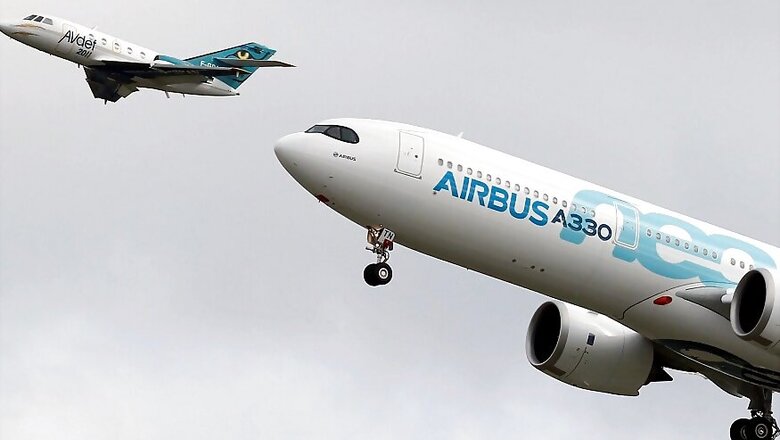
views
In 2019, India handled 2.6 million commercial air traffic movements. That is, approximately 7,000 flights criss-crossed the Indian skies daily. Yet in most cases the flights did not take the most direct path (which is a straight line) because of a number of reasons. These include, navigation aids, radar coverage and above all airspace restrictions.
In one of the aviation sector reforms announced on Saturday as a part of the stimulus package, the finance minister has highlighted that these restrictions on airspace will be eased. The outcome: more direct routes for airlines (read: shorter) which consequently means lower emissions and fuel burn.
Airspace over India to only get busier
The airspace of India covers 2.8 million square nautical miles including 1.04 million square nautical miles of continental airspace and another 1.74 million square nautical miles oceanic airspace (Bay of Bengal, Arabian Sea & Indian Ocean). Of this airspace, 65 per cent is controlled by the military while the remaining is controlled by the Airports Authority of India (AAI). As air-traffic has expanded by double digits, more aircraft have taken to the skies. Concurrently, the challenge of routing these aircraft, managing air-traffic flows and ensuring the system functions smoothly have compounded.
From 2010 to 2019, the number of air-traffic-movements over the Indian skies doubled from 1.36 million to 2.60 million. And as fuel and emissions became critical points of competitiveness and as technology grew exponentially, there was a push by several stakeholders to optimise the use of the airspace.
That is, all flights want the most direct paths to their destination. One method of doing this was allowing the use of restricted air-routes for civilian fights subject to safeguards. Termed as: flexible use of airspace or FUA.
Challenge of coordinating flexible use of airspace
The challenge of flexible use of airspace is the coordination amongst diverse stakeholders. These include the Ministry of Defence (MoD), Indian Air Force (IAF), Ministry of Civil Aviation (MoCA), Directorate General of Civil Aviation (DGCA), Airports Authority of India (AAI) and also Indian Space Research Organization (ISRO).
Each organization has a different priority and varied mission profiles. Coordinating all of these functions towards a cohesive and collaborative shared use of a national strategic resource, namely airspace, is challenging to say the least.
As early as 2012, there was discussion between the Ministry of Defense (MoD) and Ministry of Civil Aviation for flexible use of airspace (FUA). The implementation was to be subject to safeguards given the national security implications.
To this end the National High Level Airspace Policy Board was formalized in 2013. The boards mandate was to establish procedures for allocation of airspace and develop a manual on the flexible use of airspace. The manual was published in August 2014. The full implementation is likely to now see light of day.
How flexible use of airspace works
FUA allows both military and civil users to share airspace that traditionally has been exclusive to military users. For instance flights on routes such as Kolkata – Chennai, Bengaluru – Vizag or Mumbai - Srinagar were planned around a somewhat circuitous route to avoid military airspace.
The result was additional flight time which in some cases was up to 25 minutes. And with aircraft consuming fuel at a rate of 60 – 70 litres per minute, it makes for a big impact. With each extra minute in the air, the aircraft burns more fuel and puts out more emissions. Consequently, it results in a higher cost of operations to the airlines.
With flexible use of airspace, airlines will likely get a more direct routing for several routes. It may be noted that FUA is not a blanket approval to use the routes rather is dependent on coordination and collaboration between the stakeholders. The armed forces priority is not compromised in any manner.
When done effectively, FUA translates into more direct routings for civilian flights, lesser fuel burn and better cost effectiveness as significant flight volumes between cities, and especially metro cities, are in proximity to an air-base (such as Yelahanka in Bengaluru) or where significant portion of the airspace is restricted (for instance in Delhi up to 70% of the airspace is restricted).
With FUA there are key city pairs that will now get “more direct routings” including the heavily travelled Delhi-Mumbai sector which will see a reduction of approx. 15 – 30 minutes on average.
For airlines with razor thin margins and where each element of cost adds up exponentially, the numbers put out indicate a savings of Rs 1,000 crores per year. While the numbers can be debated as they are dependent on a variety of inputs, including the price of fuel and other assumptions, industry experts agree that the move towards flexible use of airspace is certainly a step in the right direction. If the implementation goes well, future flyers can expected to see shorter flight times – at least once they are airborne.

















Comments
0 comment